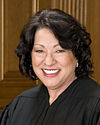Supreme Court of the United States

Back row (left to right): Amy Coney Barrett, Neil Gorsuch, Brett Kavanaugh, and Ketanji Brown Jackson. Front row (left to right): Sonia Sotomayor, Clarence Thomas, Chief Justice John Roberts, Samuel Alito, and Elena Kagan
The Supreme Court of the United States is the highest court in the United States of America. Because of this, the Court leads the Judicial Branch of the United States Federal Government. It is the only U.S. court established by the United States Constitution. Its decisions are supposed to be followed by all other courts in the United States. Since 1935, the Court has met in its own building in Washington, D.C.; before that, it met in the United States Capitol.
Background
[change | change source]There are 9 justices on the court now: one Chief Justice and eight Associate Justices. Courts (a set of all justices of the court while one Chief Justice is serving) are unofficially named for the Chief Justice; the current Court is called the "Roberts Court" after Chief Justice John Roberts.
The Supreme Court chooses which cases it will decide on, by choosing to give a writ of certiorari or not.[1] Almost 7,000 people, known as petitioners, ask the Supreme Court to decide their cases every year, but the court only gives a writ to about 100 or less.[2] For the Supreme Court to decide a case, the case must be about: federal law, the Constitution of the United States, disagreements between states or their residents, or another court's decision that differs from what the Supreme Court has decided on a similar case. Cases must first be decided by a federal district court and a federal court of appeals or by a state supreme court. Even after that, the Supreme Court can choose not to decide a case for any reason. Cases about disagreements between states or their residents sometimes can only be decided by the Supreme Court, but those are rare.
The justices serve for life unless they want to retire earlier or are impeached. If a justice retires, he or she can still be asked to serve as a judge on a federal Court of Appeals. New justices are nominated (picked) by the President of the United States, and then must be approved by the United States Senate.
The most recent justice to be chosen is Ketanji Brown Jackson, who was nominated by President Joe Biden in February 2022, to replace retiring Justice Stephen Breyer. After the Senate approved her, Jackson became the first female African American justice.[3]
The current Court
[change | change source]Living former justices
[change | change source]| Justice Birthdate and place |
Appointed by | Retired under | Age at | Tenure | |||||
|---|---|---|---|---|---|---|---|---|---|
| Start | Retirement | Present | Start date | End date | Length | ||||

|
Anthony Kennedy July 23, 1936 Sacramento, California |
Reagan | Trump | 51 | 82 | 88 | February 18, 1988 | July 31, 2018 | 30 years, 163 days |

|
David Souter September 17, 1939 Melrose, Massachusetts |
G. H. W. Bush | Obama | 51 | 69 | 85 | October 9, 1990 | June 29, 2009 | 18 years, 263 days |

|
Stephen Breyer August 15, 1938 San Francisco, California |
Clinton | Biden | 55 | 83 | 86 | August 3, 1994 | June 30, 2022 | 27 years, 319 days |
References
[change | change source]- ↑ 28 U.S.C. § 1254
- ↑ Mauro, Tony (October 21, 2005). "Roberts Dips Toe into Cert Pool". Legal Times. Archived from the original on June 2, 2009. Retrieved October 31, 2007.
- ↑ Leu, Kristen (2022-02-27). "United States: First black woman judge nominated in Supreme Court". Khaleej Mag - News and Stories from Around the World. Retrieved 2022-02-28.
- ↑ 4.0 4.1 "Current Members". www.supremecourt.gov. Washington, D.C.: Supreme Court of the United States. Retrieved October 21, 2018.









